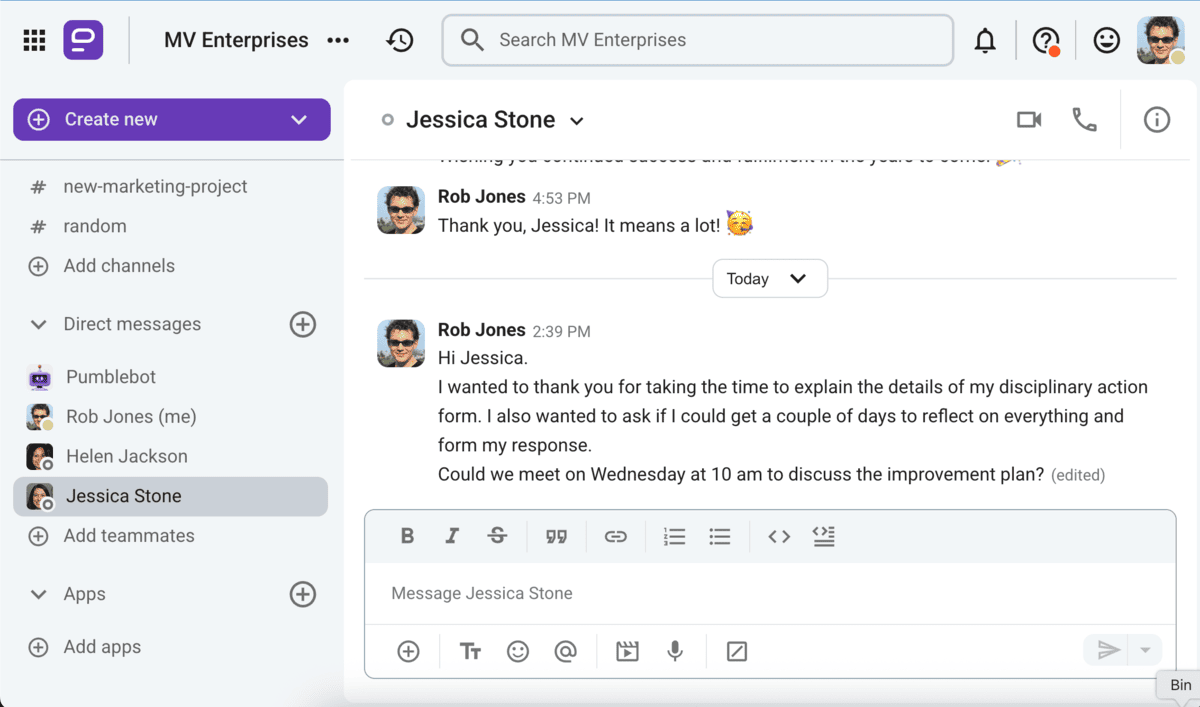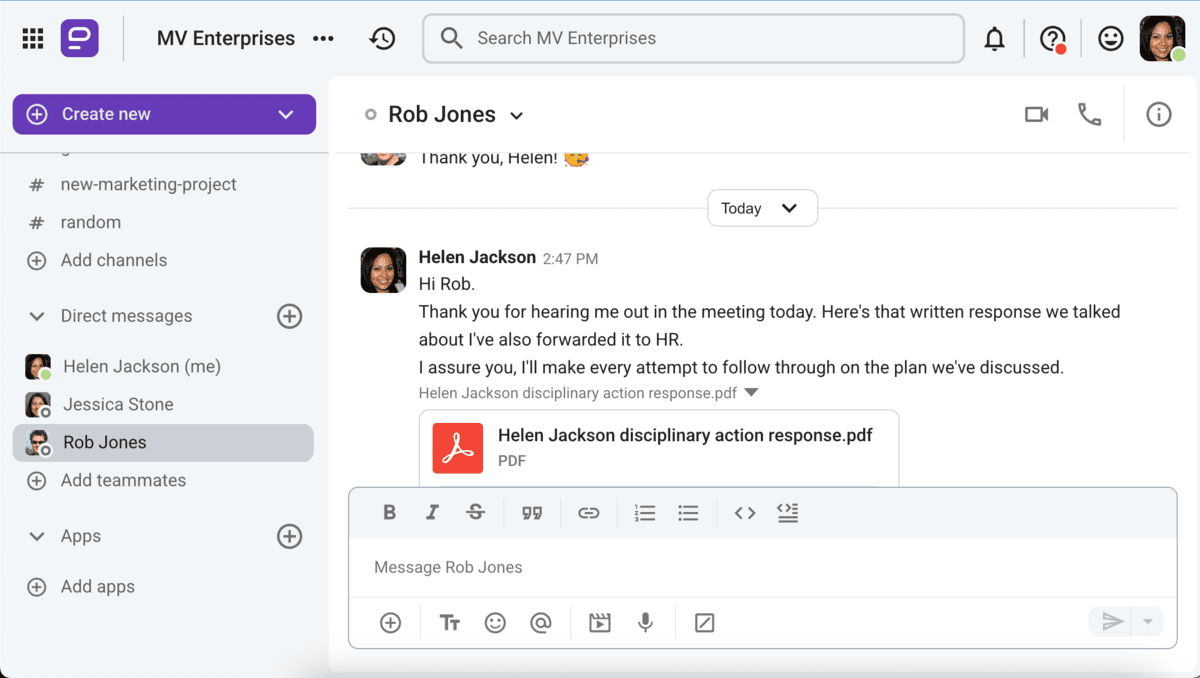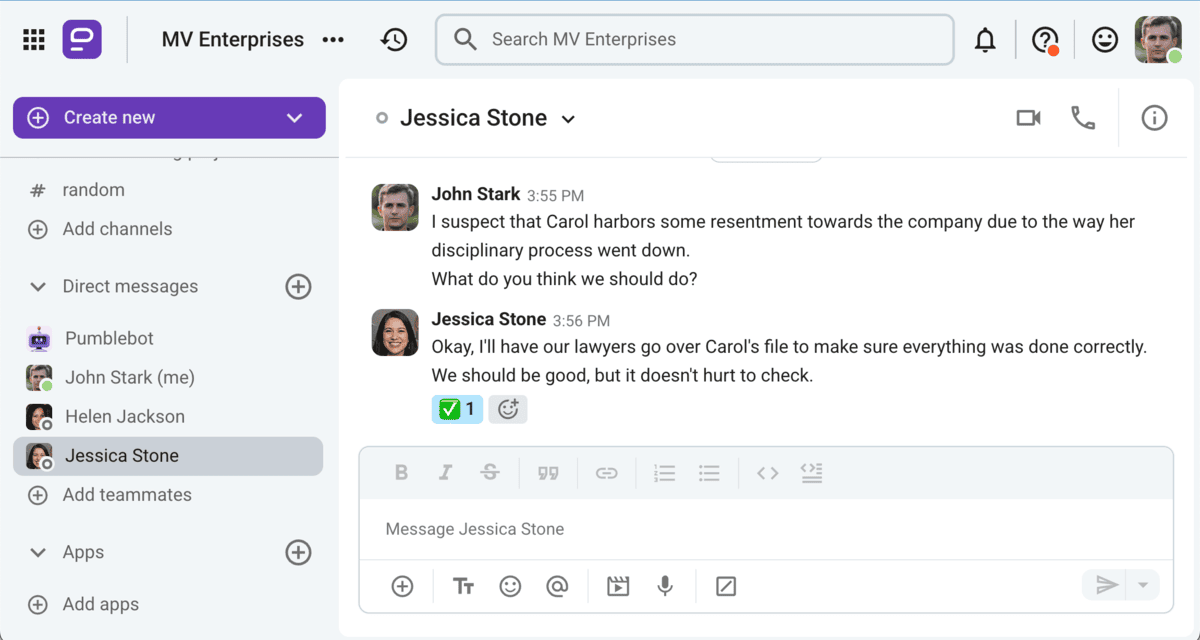No one looks forward to a work write-up. Being on either side of that conversation is undeniably unpleasant, and most of us would rather avoid it entirely.
This shared discomfort often leaves people feeling unprepared and unsure how to proceed when they find themselves in the midst of a disciplinary process.
But what if you didn’t have to navigate it blindly?
Our guide is here to demystify the process, offering clear next steps — whether you’re getting written up at work or have the tough task of issuing a work write-up yourself.

Table of Contents
What is a write-up at work?
A write-up at work is a formal, written document that informs an employee they’ve violated company policies or regulations.
It’s typically an escalation in a disciplinary process known as progressive discipline.
In most organizations, employees receive at least one verbal warning from their manager or an HR representative before being written up at work.
This disciplinary action can stem from various issues, including:
- Dress code violations,
- Poor performance,
- Tardiness or absenteeism,
- Disregarding safety protocols,
- Misuse of company resources,
- Workplace violence, bullying, or harassment,
- Working under the influence of drugs or alcohol, or
- Being the subject of multiple employee or customer complaints.
If an employee’s behavior or performance doesn’t improve, a manager might issue a final written warning before further escalating the issue, potentially leading to termination.
What to do after receiving a work write-up?
Being written up at work is an anxiety-inducing experience even if you believe your employer’s intentions are pure.
Whether you’re dealing with a legitimate work write-up or an unprovoked one, the following tips should come in handy:
- Stay calm and professional,
- Ask clarifying questions and take notes,
- Respond in writing,
- Make a genuine effort to adjust your behavior — and keep a record of your progress, and, if necessary,
- Contact an employment lawyer.
Taking these steps will help you avoid getting fired and legally protect yourself from unfair accusations.
Step #1: Stay calm and professional
When your manager pulls you aside to deliver your write-up at work, refrain from emotional outbursts. Don’t cry, shout, point fingers, or offer to quit in a fit of rage — all of this will be held against you.
Instead, take the time to actively listen to what your manager is saying and try to consider whether the complaint might be legitimate.
Think about what a completely neutral third party — such as a jury — might think about your case.
💡 Pumble Pro Tip
Staying calm and professional is not always easy, especially in a stressful situation, such as receiving a write-up. To be better equipped to handle difficult situations, read up on how emotional intelligence plays a role in workplace behaviour and relationships:
Step #2: Ask clarifying questions and take notes
If there’s any part of the work write-up form you don’t understand, ask your manager (or the HR person who serves you the documents) to repeat why you’re being disciplined.
Feel free to take notes and ask clarifying questions such as:
- What exactly did I do wrong?
- Who made the initial complaint?
- When did this happen?
If you can’t think of any questions you’d like to ask, ask your employer to give you a couple of days to reflect on the issues that have been raised and schedule a follow-up meeting.

Communicate effectively with Pumble
💡 Pumble Pro Tip
Whether you’re an employee or a manager, dealing with a write-up at work will most likely require you to ask some pretty tough questions. This guide will help you learn how to do so without seeming upset or disrespectful:
Step #3: Respond in writing
When you are presented with the disciplinary action documentation, you may feel tempted to come to your own defense right then and there.
However, with your emotions running high, you may not be able to deliver a rational response.
With that in mind, it’s best to hold back and respond in writing. That will allow you to:
- Practice respectful communication and affirm your loyalty to the company,
- Reference company policies and point out any relevant inconsistencies,
- Specify which parts of the write-up are true and false and attach copies of evidence, and
- Mention if you believe that you are being targeted due to a protected characteristic (such as race, gender, sexuality, or religion) or activity (for example, if the write-up comes after you’ve complained about workplace safety).
Be polite, professional, and brief — your response should be no longer than 5 paragraphs.
If nothing else, responding rationally should help any potential legal suits you may file later on.

Send files to your team via Pumble
Step #4: Make a genuine effort to adjust your behavior — and keep a record of your progress
Whether the write-up is justified or not, you should at least make an effort to take responsibility.
Try to follow the action plan your employer has put together — and be sure to keep a record.
Let your manager know how you’re doing and ask them if they think you’re moving in the right direction.
Screenshot any positive feedback you receive.
Alternatively, if you don’t receive any positive reinforcement, that may be a sign that you should start looking for other employment opportunities.

Stay connected with your employees via Pumble
Optional step: Contact an employment lawyer
If things escalate and you start suspecting that someone at work is setting you up, contact an employment lawyer who specializes in your state or country’s employment laws and laws regarding write-ups at work.
Even if you’re not skeptical about your employer’s intentions, an employment lawyer could help you understand the laws regarding write-ups at work and draft your response.
How to write up an employee as a manager or an HR professional
If you’re a manager or HR professional, approaching a work write-up should be about delivering corrective advice, not punishment.
Here’s how to effectively draft and deliver a write up form:
- Create a note to file. Before writing someone up, check their history of behavioral or performance issues. A note to file documents previous informal warnings, including what the verbal warning was about and the employee’s response. This allows you to mention past infractions in the formal employee write-up.
- Fill out an employee write-up form. If the employee has repeatedly violated company policy, complete a disciplinary or corrective action form. Clearly explain what the employee did, when it happened, what they should have done instead, and what happens next.
- Schedule a meeting to deliver the write-up. Schedule a one-on-one meeting with the employee. Ensure they have an idea of the meeting’s purpose, choose a location that won’t intimidate them, and consider having a witness present if necessary, especially for behavioral issues. HR should be informed from the beginning to avoid accusations of favoritism or bias.
- Hand over the documents. During the meeting, review the write-up form with your employee to ensure they understand what’s happening. The employee should receive copies of all relevant documents and sign the write-up. Emphasize that signing doesn’t mean they admit wrongdoing, but rather acknowledge they were made aware of the disciplinary process. If an employee refuses to sign, make a note of it on the form.
- Take responsibility. To help the employee understand the company wants them to improve, practice empathic communication. Ask how you can support them in implementing the improvement action plan. Acknowledge any part your behavior or leadership might have played in their issues. Be prepared to monitor their progress and follow through with the outlined consequences.
Hold unlimited one-on-one meetings over Pumble
Work write-up form example
Most people who’ve never had to issue a write-up at work should still be able to fill in the basic fields of the form.
However, the description of the incident and the expectations part of the form may be more difficult to produce, especially for those who’ve never had to formally discipline employees before.
With that in mind, we’ve prepared an example of a supervisor statement:
“On Wednesday, March 13th, the company received several customer complaints about customer support agent, Carol Green. Green’s unpleasant attitude affected the customer’s emotional state as well as their perception of the company. Moreover, her aggressive behavior has also affected her coworkers’ work performance.
Green previously received several customer complaints in February, on the 6th, 20th, and 23rd, at which point her supervisor issued a verbal warning and was assured that the employee would make an effort to correct this behavior.
In the interest of helping the employee work through this issue, the company has signed her up for a 4-week anger management course. Green will also be expected to report back on her progress during 4 follow-up meetings with her supervisor, which will take place on Fridays at 11 a.m.
This document will serve as the first of 2 written warnings issued to the employee regarding this matter. The second warning will trigger a temporary pay reduction and the final warning will precede a termination of the employee’s contract.”
For a more customizable version of the text we just shared, check out our work write-up template.
⬇️ Get a free employee write-up form template
Why are work write-ups important?
Ultimately, work write-ups are useful tools for:
- Building a positive and productive work environment,
- Reducing the number of employee terminations, and
- Providing legal protection against wrongful termination suits.
If you ever feel bad serving or receiving a write-up at work, just think about these benefits.
Reason #1: Building a positive and productive work environment
Disciplining disruptive employees can help create a more positive work environment for other team members.
After all, having to deal with difficult coworkers can negatively affect employee morale, causing productivity to drop.
So, identifying employees with behavioral or performance issues and helping them improve can lead to a better work environment all around.
💡 Pumble Pro Tip
One of the most important factors of a positive work environment are healthy relationships within a team. Unfortunately, it can be hard to maintain healthy relationships with coworkers who are difficult to deal with. In our blog post, we cover some actionable steps you can take to more easily deal with difficult team members:
Reason #2: Reducing the number of employee terminations
If employers and employees alike are willing to take the improvement plan that’s usually included in the write-up form seriously, we can see how getting written up at work may reduce the overall number of terminations.
However, the successful implementation of those action plans usually takes commitment and participation from both sides.

Reason #3: Providing legal protection
Last but not least, write-ups also provide legal protection against wrongful termination or retaliation suits.
Simply put, these documents can serve as proof that the company has taken steps to correct employee behavior or improve their performance before resorting to termination.
Alternatively, the paperwork connected to the work write-up — such as the employee’s written response — can also help the employee legally protect themselves.

FAQ about work write-ups
Now that we’ve gone over the basics of issuing and receiving disciplinary write-ups at work, let’s answer some frequently asked questions.
What does an employee write-up document contain?
A work write-up is a formal document that lists:
- An employee’s name and position within the company,
- The employee’s department as well as the name of their supervisor,
- The type of policy violation they have committed, and
- The current date (and, sometimes, the time frame during which the employee must correct their behavior or performance).
This document also contains larger sections devoted to:
- The supervisor’s statement, which contains a factual description of the incidents that led to the write-up as well as any evidence the employer has,
- A corrective action plan or the expectations the employer has of the employee (which may include additional training, follow-up meetings, and potential consequences of not meeting expectations), and
- The employee statement, which allows the employee to respond to the allegations in the document.
Can one be written up at work without a verbal warning?
Depending on the circumstances, some employers may file an official disciplinary action form the first time an employee violates a company policy.
These situations are usually more serious infractions of company policy or the law, such as:
- Insubordination, excessive tardiness or absenteeism, misuse of company resources,
- Serious misconduct such as theft, physical violence, harassment, or
- Serious safety or confidentiality violations.
Still, most people will have received a verbal warning before getting written up at work.
Can a company terminate an employee without a write-up?
Unless your employee contract states otherwise, chances are, your company can fire you with little to no warning as long as the reason isn’t illegal. That is the main feature of at-will employment.
However, most companies still make a point of going through the motions of a progressive discipline process, allowing them to have a paper trail in case the terminated employee comes back with a wrongful termination suit.
What is the difference between a warning and a write-up?
A warning is usually seen as an informal verbal notification an employee receives from their supervisor upon violating a company policy for the first time.
Even though write-ups are seen as the first official document in a disciplinary process, verbal warnings can go on an employee’s record in the form of a file note.
Do I have to sign a write-up at work?
Employees can technically refuse to sign any documents they get at work. However, doing so can be seen as an act of insubordination.
In any case, signing the disciplinary action document doesn’t mean that you agree with its contents.
Still, if you’re worried, you can always make a note that you don’t agree with all the points made in the formal document before signing it.
Should I quit my job if I get a write-up at work?
“I got written up at work, should I quit?”
This is a common question.
Before deciding, consider:
- If the write-up is legitimate,
- If you’re willing to adjust your employee behavior, and
- If your employer is genuinely trying to help you succeed.
If you’re consistently receiving negative feedback despite your best efforts, or if you feel targeted, then exploring other employment opportunities might be a good idea.
But, on the other hand, a write-up can be a chance to improve and show commitment.
In any case, receiving a write-up at work shouldn’t be the only deciding factor in your decision to quit your job.
Pumble helps professionals deal with a write-up at work
Throughout this guide, we have demonstrated how the employee communication app, Pumble, could support every step of the disciplinary process.
You can use Pumble to:
- Privately set up meetings through direct messages,
- Have video calls to deliver the news and follow up with employees,
- Record meetings to have on file,
- Securely share documents related to the employee write-up, and
- Pin messages and set reminders to revisit important topics.

Pumble’s features can make even the most unpleasant work interactions easier.







